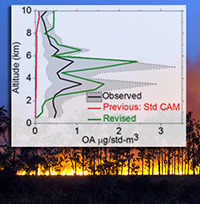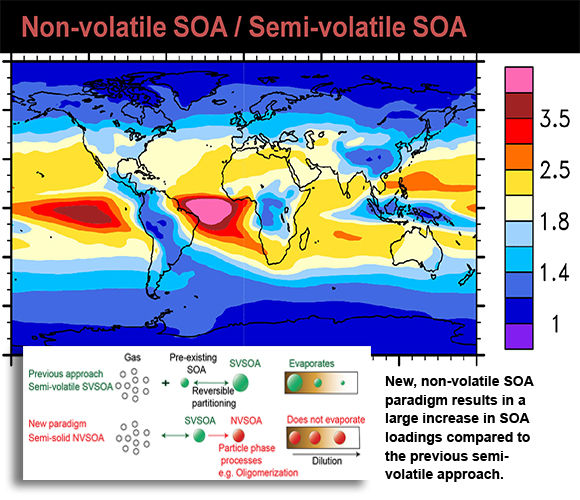Atmospher Sci & Global Chg
Research Highlights
June 2015
New Research Nabs #1 Particle Pushers
PNNL global model treatments reveal much larger climate impact from burning vegetation and biofuel emissions

Forming SOAs. From African brush fires, forest fires in the U.S. west, burning peat and dung for heating, or clearing land with fire in the Amazon, burning biomass and biofuel are emitting large amounts of SOA instigators. A newly revised SOA model (green) offers much better agreement with observational measurements of organic aerosols (OA) measured downwind of biomass-burning plumes that have reached all the way to the Arctic. The previous model (red line) completely fails to simulate organic aerosol.
Results: Until now, trees have unjustly taken the blame. Many climate models point to live vegetation as the largest contributor of particle-making vapors in the atmosphere, because of the models' rudimentary assumptions about particles. But new research led by Pacific Northwest National Laboratory shows, for the first time, that burning vegetation and bio-based fuel are the largest sources of particle-making vapors in the atmosphere.
These particles, called secondary organic aerosols (a.k.a. SOA), especially those from high-altitude biomass-burning emissions, are largely absent in global models so their climate-changing effects are hard to nail down. Using the latest ground-breaking measurements of the particles' formation and lifetime, the researchers developed new modeling systems and implemented them in a community atmosphere global model. The new systems show agreement with a suite of aircraft, satellite, and surface measurements. The discovery translates to an order-of-magnitude change in the impact of SOA on the Earth's energy balance.
"These findings could transform our understanding of how particles form and evolve in the atmosphere and point to the importance of organic vapors emitted from biomass fires fossil-fuels and trees," said Dr. ManishKumar Shrivastava, atmospheric scientist and lead author of the study.
Why It Matters: Unseen by the naked eye, large quantities of carbon-containing vapors enter the atmosphere as they escape from trees, fossil-fuel burning, and forest fires. The atmosphere is like a large chemical reactor, "cooking" these emissions to form millions of new carbon-containing molecules. Some of these molecules then condense into nano-particles that can change clouds, precipitation, and the amount of solar energy reaching the Earth.
Implementing new measurement insights about their make-up, the researchers showed that these particles are able to survive much longer in the atmosphere, especially during long journeys over cleaner regions such as oceans, an outcome in contrast with traditional models which predict they largely evaporate during their journey. This work clearly shows that global climate models need to move away from crude SOA treatments and start accounting for the state-of-the-art knowledge gained from recent measurements about organic aerosols.
Methods: The PNNL-led team, with collaborators from the University of Wyoming, University of Colorado at Boulder, University of California-Davis and University of Eastern Finland implemented the most sophisticated treatment yet of SOAs based on newly developed knowledge of processes governing SOA formation and evolution. They used an approach that classifies volatility and oxidation characteristics of thousands of organic compounds into 2-D bins for computational efficiency. With this approach, the research represented multigenerational aging of thousands of organic compounds in the atmosphere for the first time within the global Community Atmosphere Model version 5 (CAM5).
The research tracked SOA formation within the model from three different sources: vegetation plus biofuel fires, fossil-fuels, and trees, which allowed them to separate the contribution of these sources to SOA particle formation. The multigenerational chemistry approach included functionalization (addition of functional groups to the carbon chain: decreasing volatility) and fragmentation reactions (breaking of carbon-carbon bonds: increasing volatility), implemented for the first time in a global model. The team then evaluated both their revised and the previous default simplified SOA approach in CAM5 with a suite of surface, airborne, and satellite observations from around the world. The analysis showed conclusively that their new modeling approach resulted in large improvements.

The capacity of SOA to affect the Earth's energy balance predicted by the revised treatment is an order of magnitude higher than previously estimated by most models. The new research also found large changes in simulated lifetimes, and horizontal and vertical distribution of these particles compared to the default simplified model.
"The impact of these aerosols on our climate system is likely much larger than previously understood," said Shrivastava.
What's Next? The new model formulations will be modified to increase their computational efficiency for long-term climate simulations. The researchers are also working to evaluate the implications of their new model findings on clouds, precipitation, and climate change in the present day compared to preindustrial times.
Acknowledgments
Sponsors: This was work was supported by the U.S. Department of Energy (DOE) Office of Science Biological and Environmental Research's (BER's) Earth System Modeling Program through the Applying Computationally Efficient Schemes for BioGeochemical Cycles project under Scientific Discovery through Advanced Computing (SciDAC-3), and by the DOE's Office of Science BER's Atmospheric Systems Research (ASR) Program.
Research Team: ManishKumar Shrivastava, Richard Easter, Alla Zelenyuk, Balwinder Singh, Kai Zhang, Po-Lun Ma, Duli Chand, Steven Ghan, Jerome Fast, and Philip Rasch, PNNL; Xiaohong Liu, University of Wyoming; Jose L. Jimenez, University of Colorado at Boulder; Qi Zhang, University of California Davis; and Petri Tiitta, University of Eastern Finland.
Research Area: Climate & Earth Systems Science
User Facility: EMSL, the Environmental Molecular Sciences Laboratory, a DOE Office of Science User Facility and the National Energy Research Scientific Computing Center (NERSC) provided resources for the research. Computational resources for the simulations were provided by the PNNL Institutional Computing (PIC) facility, EMSL and NERSC.
Reference: Shrivastava M, R Easter, X Liu, A Zelenyuk, B Singh, K Zhang, P-L Ma, D Chand, S Ghan, JL Jimenez, Q Zhang, J Fast, P Rasch, and P Tiitta. 2015. "Global Transformation and Fate of SOA: Implications of Low Volatility SOA and Gas-Phase Fragmentation Reactions." Journal of Geophysical Research-Atmospheres, accepted. DOI: 10.1002/2014JD022563
Related Highlights: Following the Aerosol Trail, Pollution Hitches Ride to Arctic, Crossing the Atmosphere's Next Frontier
